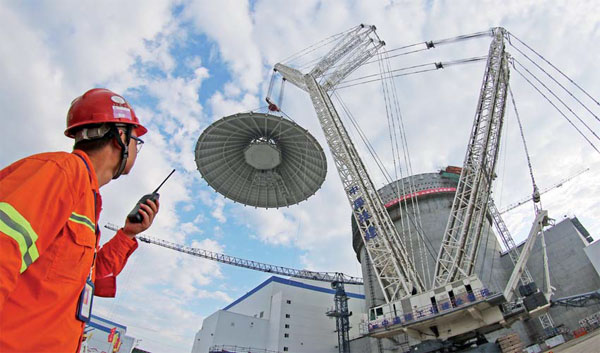A matter of degrees
Updated: 2015-11-27 07:56
By Fu Jing and Lan Lan(China Daily Europe)
|
|||||||||||
|
Haiyang Nuclear Power Station in Shandong province under construction in September. One in every 4 kilowatt-hours of electricity in China comes from low-carbon sources, mostly renewables. Photos provided to China Daily |
Last year saw the first decline in China's coal output after 15 years of consecutive growth. Industries such as cement, power, steel and chemicals are facing overcapacity and more stringent environmental standards.
Things are changing as the economy entered the new normal, which means slower but more sustainable growth. Slowing production at major coal consumers has dragged down coal consumption.
China reported a 5.7 percent year-on-year decline in coal consumption in the first nine months of this year, after a 2.9 percent decline in 2014.
Tim Buckley, director of energy finance studies at the Institute for Energy Economics and Financial Analysis, says coal production and coal imports in China peaked in 2013, and the rate of decline in both production and imports accelerated throughout 2014 and 2015.
While a single year or two is not sufficient to predict that China's coal consumption will continue to fall, coal use has entered a steady status and will be on track to fall after 2020, says Tsinghua's He.
Chinese leaders have stressed that cutting emissions "is not at others' request but on our own initiative" and the promotion of clean energy and energy efficiency has been highlighted in proposals for the 13th Five-Year Plan (2016-20).
Achim Steiner, executive director of the UN Environment Programme, says it is a "fascinating moment in history" that has seen China incorporate eco-civilization into its future development path.
The country's cumulative investment in promoting nonfossil fuels and developing low-carbon technologies is likely to exceed 40 trillion yuan ($6.2 trillion; 5.9 trillion euros) between 2015 and 2030, estimates the National Center for Climate Change Strategy and International Cooperation, a think tank.
It is expected to create new opportunities in ecological restoration and renewable-energy technology, both for domestic and international companies.
Beyond numbers
In fact, China has attached great importance in transforming its development patters to shift away from energy- and resources-intensive models. Especially since President Xi took office in 2013, the new leadership has emphasized the concept of ecological civilization, which is one of the five pillars of China's society.
Janos Pasztor, UN's assistant secretary-general on climate change, says the concept of an ecological civilization reflects a shift in the development policies of China, and a concrete way to promote and achieve sustainable development.
"And it is of particular significance for the implementation of the 2030 Sustainable Development Agenda and global efforts to address climate change," says Pasztor.
"This shift is essential because taking timely and universal action on climate change is the way the world can achieve sustainable development goals to end poverty, (and) build stronger economies and safer, healthier societies everywhere."
China's recent development path will help it handle increasing pressure from resource consumption and environmental degradation, Pasztor says. "It will also demonstrate to the rest of the world, and to other developing countries in particular, that it is possible to pursue a new development path that is more sustainable and climate friendly."
Samantha Smith, leader of the World Wildlife Fund Global Climate and Energy Initiative, says although there are some economic challenges, China's determination to achieve a green and low-carbon transition remains strong.
Smith says the economic growth rate of the world's largest developing country is lower, but it is still high among all major countries.
"At the same time, energy and carbon intensity dropped significantly, and the increase of renewables in China's primary energy mix is quite remarkable," she says.
One in every 4 kilowatt-hours of electricity in China comes from low-carbon sources, mostly renewables. "According to these numbers, China is fully expected to over-deliver its targets in the 12th Five-Year Plan (2011-2015) and is right on track for its pre-2020 pledge," Smith says.
"This is a very encouraging sign that a low-carbon transition won't compromise but rather strengthens social and economic progress."
The world has seen a welcome and rapid evolution of thinking in China, away from the old carbon-intensive development model and toward a more progressive set of priorities, including sustainability, a circular economy and low-carbon development, according to Isabel Hilton, a London-based journalist and founder of China Dialogue, an independent, nonprofit organization that focuses on the environment.
"This will require a profound transformation, not only of the economy and the energy sector, but also of environmental governance," she says.
Today's Top News
China ready for risks after yuan included in SDR
Premier League coaches to aid China's soccer goal
Chinese companies invest in City Football Group
Investment expected as Xi arrives in Zimbabwe
Xi's Zimbabwe visit to elevate bilateral ties to new high
Xi says climate summit a 'starting point'
Xi warns against mentality of zero-sum game
What world leaders say about the planet's future
Hot Topics
Lunar probe , China growth forecasts, Emission rules get tougher, China seen through 'colored lens', International board,
Editor's Picks

|

|

|

|

|

|








